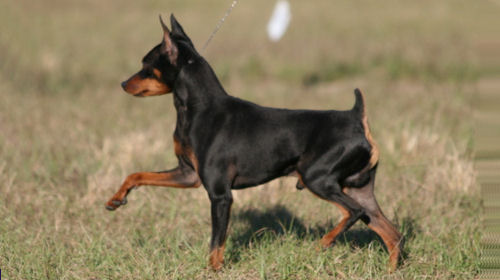
The Breed History
The Miniature Pinscher is not bred down in size from Doberman
Pinscher stock, in fact, the MinPin is a much older breed (predates
the Doberman by about 200 years). In the 1800s, writings suggest
Italian Greyhound and Dachshund were contributors to breed
development. Records date back perhaps 2000 years and the
German Pinscher may in fact be the original larger breed ancestor.
The origins of the breed are in Scandinavia and particularly, later in
Germany. Pinscher means biter or terrier. The AKC registry admitted
the breed in 1929.
Breeding for Function
Historically, they served as valuable rodent control dogs. Watchdog
and companionship are two other roles that they play.
Physical Characteristics
Height at Withers: 10-12.5" (25.5-32 cm).
Weight: 8-10 lb (4-4.5 kg).
Coat: The glossy, short flat-lying coat has a hard, smooth hair
texture. Red, stag red (red and black hairs), chocolate with rust,
black with tan (red) are the accepted coat colors.
Longevity: 13-14 years
Points of Conformation: Small, compact and almost square
in conformation, the MinPin has oval large dark eyes; palpebral
margins are black or self in chocolates. The head is flat, they have
a tapering narrow muzzle, the stop is slight, nose is black or self
in chocolates, and lips are close and dry. The ears are prick and
large, the neck is moderate in length and muscling, slightly arched,
and not throaty. The topline is level to mildly sloping down to the
rear, and the thorax deep with well sprung ribs. The abdomen is
moderately tucked up. Limbs are straight boned and dewclaws are
usually removed. Feet are compact, with well knuckled up toes, and
nails are thick. The tail is high set, carried high and may be docked
to a short length. The gait is described as "hackney-like" due to the
very high stepping, quick action similar to the hackney horse.
Recognized Behavior Issues and Traits
Reported breed characteristics include: Low grooming needs, loyal
and affectionate, good watchdog, high spirited, alert, can be snappy,
brave against dogs much larger, curious, extremely high activity levels,
good with sensible, quiet gentle children, moderately good trainability,
good escape artists, and should not be off leash unless in a fenced
enclosure. They are known to have a moderate barking tendency.
Normal Physiologic Variations
Dilute coat color is due to the homozygous recessive expression of
a mutation in the melanophilin gene (MLPH). This can predispose to
color dilution alopecia.
Drug Sensitivities
None reported
Inherited Diseases
Legg-Calve Perthes Disease and Hip Dysplasia: Polygenically
inherited traits causing degenerative hip joint disease and arthritis.
Legg-Calves Perthes disease is considered a significant problem in
the breed, however too few Miniature Pinschers have been screened
by OFA to determine an accurate frequency. Reported 71.5x odds
ratio for Legg-Calve-Perthes versus other breeds.
Patella Luxation: Polygenically inherited laxity of patellar ligaments,
causing luxation, lameness, and later degenerative joint disease.
Treat surgically if causing clinical signs. Dorn reports an 4.87x odds
ratio for the disorder versus other breeds. Another study reports a
14.4x odds ratio versus other breeds. OFA reports 3.2% affected.
Mucopolysaccharidosis VI (MPS VI): Autosomal recessive disorder
causing skeletal deformities, including defects in the sternum,
vertebrae and particularly the hip joints. To varying degrees they
may also experience corneal cloudiness and facial dysmorphia. A
genetic test is available.
Elbow Dysplasia: Polygenically inherited trait causing elbow arthritis.
Too few Miniature Pinschers have been screened by OFA to determine
an accurate frequency.
Disease Predispositions
Corneal Dystrophy: Epithelial/stromal form causes opacities on the
surface of the cornea. Average age of onset is 1-2 years. Unknown
mode of inheritance. Identified in 5.80% of Miniature Pinschers CERF
examined by veterinary ophthalmologists between 2000-2005.
Cataracts: Anterior or posterior intermediate and punctate
cataracts occur in the breed. Onset 1.5-3 years of age. Reported
in 4.58% of Miniature Pinschers presented to veterinary teaching
hospitals. Identified in 1.79% of Miniature Pinschers CERF examined
by veterinary ophthalmologists between 2000-2005. CERF does not
recommend breeding any Miniature Pinscher with a cataract.
Vitreous Degeneration: Liquefaction of the vitreous gel which may
predispose to retinal detachment or glaucoma. Identified in 4.46%
of Miniature Pinschers CERF examined by veterinary ophthalmologists
between 2000-2005.
Hypothyroidism: Inherited autoimmune thyroiditis. 3.6% positive
for thyroid auto-antibodies based on testing at Michigan State
University. (Ave. for all breeds is 7.5%).
Persistent Pupillary Membranes: Strands of fetal remnant
connecting; iris to iris, cornea, lens, or involving sheets of tissue. The
later three forms can impair vision, and dogs affected with these
forms should not be bred. Identified in 3.57% of Miniature Pinschers
CERF examined by veterinary ophthalmologists between 2000-2005.
Color-Dilution Alopecia: Condition seen in some blue or fawn
(dilute) colored Miniature Pinschers. Starts as a gradual onset of dry,
dull and poor hair coat quality. Progresses to poor hair regrowth,
follicular papules and comedomes. Hair loss and comedome
formation are usually most severe on the trunk. Dorn reports an
8.54x odds ratio for developing alopecia versus other breeds.
Optic Nerve Hypoplasia/Micropapilla: Congenital defect of optic
nerve development affecting vision, or a small optic disc. Identified
in 1.34% of Miniature Pinschers CERF examined by veterinary
ophthalmologists between 2000-2005.
Inherited Epilepsy: Grand-mal seizures. Control with anticonvulsant
medication. Dorn reports a 5.39x odds ratio versus other breeds.
Unknown mode of inheritance.
Demodicosis: Demodectic mange dermatitis has an underlying
immunodeficiency in its pathogenesis. Dorn reports a 1.95x odds
ratio versus other breeds. Unknown mode of inheritance.
Immune-Mediated Hemolytic Anemia: Auto-immune disorder
where the body produces antibodies against its own red blood cells.
Treat with immunosuppressive drugs. There is generally a female
preponderance with this disorder. Miniature Pinschers have an
increased risk versus other breeds.
Cystinuria/Cystine Bladder Stones: Miniature Pinschers have an
increased risk for developing cystine bladder stones, due to an error
in cystine metabolism. Treat with surgical removal and life-long
medical therapy. Unknown mode of inheritance in this breed.
Portosystemic shunt (PSS, liver shunt): Congenital abnormal
blood vessel connecting the portal and systemic circulation. More
frequently intrahepatic in this breed versus extrahepatic. Causes
stunting, abnormal behavior, possible seizures, and secondary
ammonium urate urinary calculi in the breed. Treatment of PSS
includes partial ligation and/or medical and dietary control of
symptoms. Tobias reports a 7.0x odds ratio versus other breeds.
Progressive Retinal Atrophy (PRA): Degeneration of the retina
leading to blindness. Unknown mode of inheritance. Identified
in 0.45% of Miniature Pinschers CERF examined by veterinary
ophthalmologists between 2000-2005. CERF does not recommend
breeding any Miniature Pinscher with PRA.
Diabetes Mellitus: Sugar diabetes. Control with insulin injection,
diet, and glucose monitoring. Reported at an increased prevalence
in the breed. Unknown mode of inheritance.
Deafness, Ebow Luxation, Keratoconjunctivitis Sicca, and
Sebaceous Adenitis are reported.
Isolated Case Studies
Sry-Negative XX True Hermaphrodite (XX Sex Reversal):
A phenotypically male Miniature Pinscher was examined. The
chromosomal sex was female (XX), and there was an absence of
"male" causing Sry. XX Sex-reversal is familial in other breeds.
Genetic Tests
Tests of Genotype: Direct test for MPS VI is available from PennGen.
Direct test for black and chocolate coat color is available from VetGen.
Tests of Phenotype: Recommend patella examination, CERF eye
examination, hip and elbow radiographs, thyroid profile including
autoantibodies, and cardiac evaluation.
Miscellaneous
- Breed name synonyms: MinPin, Zwergpinscher, Reh Pinscher,
King of Toys (nickname).
- Registries: AKC, UKC, CKC, KCGB (Kennel Club of Great Britain),
ANKC (Australian National Kennel Club), NKC (National Kennel Club).
- AKC rank (year 2008): 32 (5,848 dogs registered)
- Internet resources: Miniature Pinscher Club of America:
www.minpin.org
The Canadian Miniature Pinscher Club:
www.cdn-miniaturepinscherclub.com
Miniature Pinscher Club of Great Britain:
www.miniaturepinscherclub.co.uk
Photo Gallery of Breed - Miniature Pinscher - Dog Breed
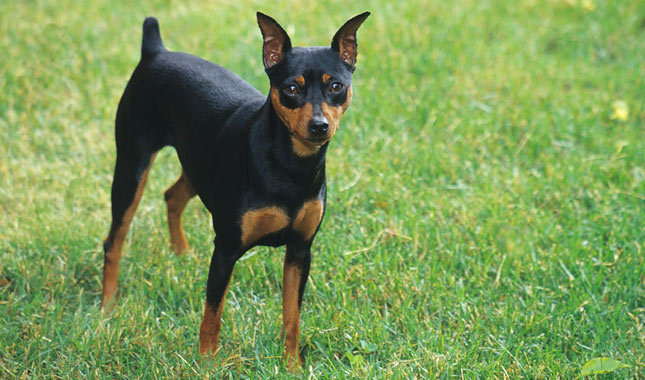


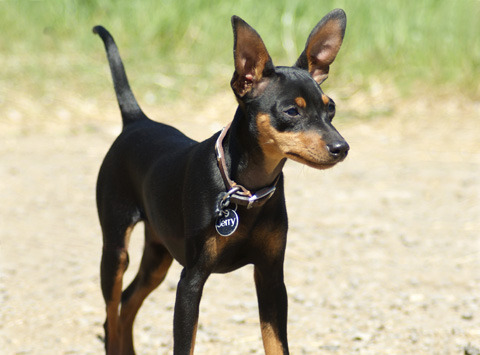
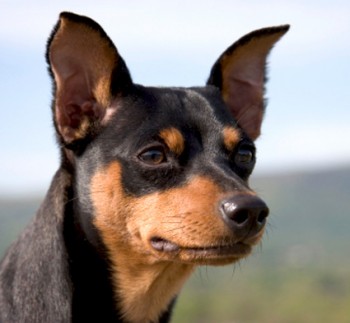

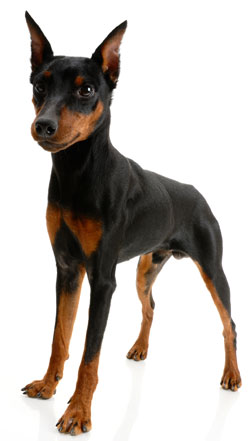

 Animalia Life
Animalia Life